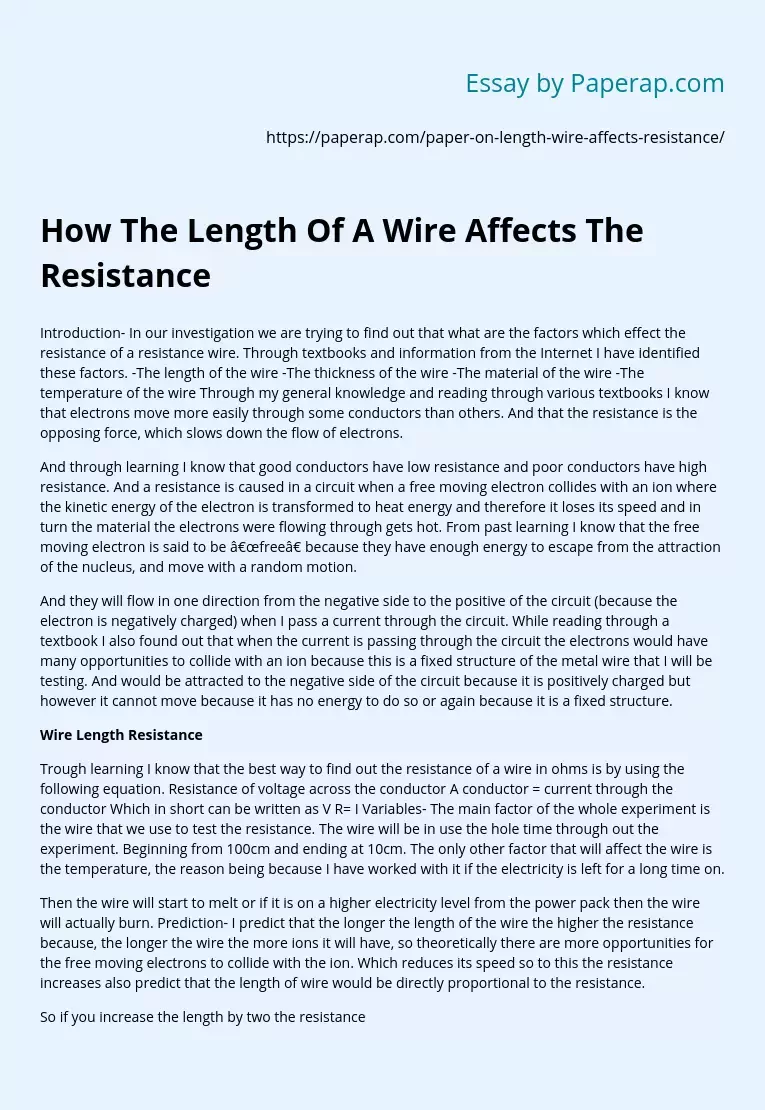How The Length Of A Wire Affects The Resistance
Introduction- In our investigation we are trying to find out that what are the factors which effect the resistance of a resistance wire. Through textbooks and information from the Internet I have identified these factors. -The length of the wire -The thickness of the wire -The material of the wire -The temperature of the wire Through my general knowledge and reading through various textbooks I know that electrons move more easily through some conductors than others. And that the resistance is the opposing force, which slows down the flow of electrons.
And through learning I know that good conductors have low resistance and poor conductors have high resistance. And a resistance is caused in a circuit when a free moving electron collides with an ion where the kinetic energy of the electron is transformed to heat energy and therefore it loses its speed and in turn the material the electrons were flowing through gets hot. From past learning I know that the free moving electron is said to be “free” because they have enough energy to escape from the attraction of the nucleus, and move with a random motion.
And they will flow in one direction from the negative side to the positive of the circuit (because the electron is negatively charged) when I pass a current through the circuit. While reading through a textbook I also found out that when the current is passing through the circuit the electrons would have many opportunities to collide with an ion because this is a fixed structure of the metal wire that I will be testing.
And would be attracted to the negative side of the circuit because it is positively charged but however it cannot move because it has no energy to do so or again because it is a fixed structure.
Trough learning I know that the best way to find out the resistance of a wire in ohms is by using the following equation. Resistance of voltage across the conductor A conductor = current through the conductor Which in short can be written as V R= I Variables- The main factor of the whole experiment is the wire that we use to test the resistance. The wire will be in use the hole time through out the experiment. Beginning from 100cm and ending at 10cm. The only other factor that will affect the wire is the temperature, the reason being because I have worked with it if the electricity is left for a long time on.
Then the wire will start to melt or if it is on a higher electricity level from the power pack then the wire will actually burn. Prediction- I predict that the longer the length of the wire the higher the resistance because, the longer the wire the more ions it will have, so theoretically there are more opportunities for the free moving electrons to collide with the ion. Which reduces its speed so to this the resistance increases also predict that the length of wire would be directly proportional to the resistance.
So if you increase the length by two the resistance would also increase by two times. I predicted this because from my past learning and the information I have gathered tells me that this is true. (GCSE physics by Duncan) clearly states the resistance of a wire is proportional to its length (quadrupling the length quadruples the resistance) And (lets revise GCSE science) also suggests, the length of wire is proportional to its resistance Apparatus- Ruler-100cm long with the wire attached to it with tape. Voltmeter -this was connected parallel to the wire.
Power pack -the supply of energy was put to two volts Ammeter -this was connected from the positive side of the power pack to the positive of the ammeter with a lead because this is the best way to get an accurate reading. Leads -this connected all the equipment Crocodile clips -this was used to connect the leads to the metal wire to let a current pass through. Variable resistor- if reading of voltmeter beyond range adjusted. Method- My circuit was set up like this: + Variable resistor Power pack Voltmeter Ammeter + + 100 cm Ruler Test wire.
In this investigation a simple circuit will be set up to read the voltage and current when the length of the wire changes. The circuit should be set up as above. The length will range from 10cm – 100cm (1m) with intervals of 10cm. Moving the crocodile clip across the wire on a ruler will change the length of the wire. If I am doing the experiment rite then I should be able to spot a pattern straight away. This way I would be able to see if the experiment is going ok. Of the pattern does not show up then the experiment that is being carried out is wrong.
How The Length Of A Wire Affects The Resistance. (2019, Dec 05). Retrieved from https://paperap.com/paper-on-length-wire-affects-resistance/

